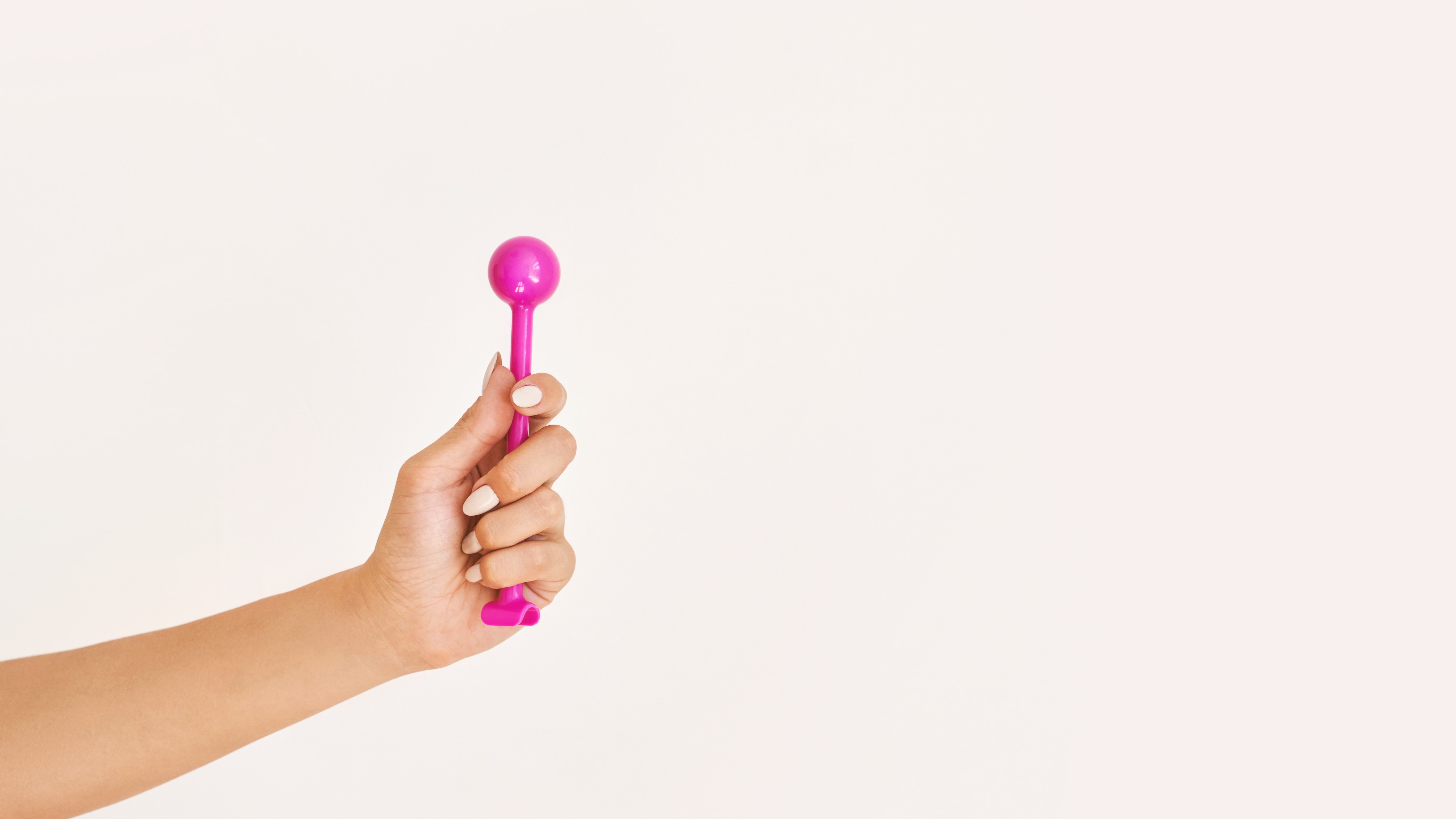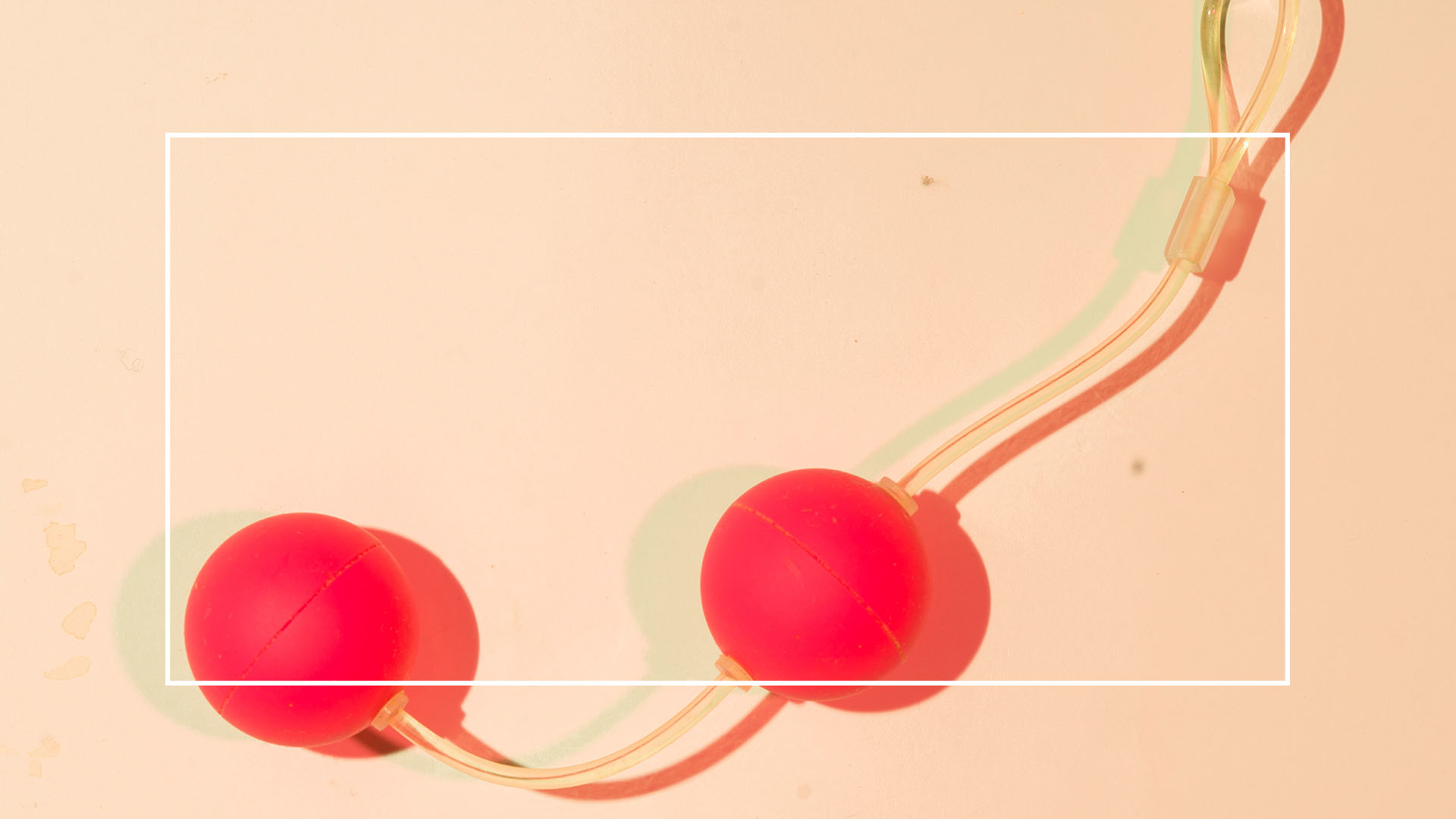Why kegel exercises are so important—plus, the key movements you need to know about
Kegel exercises can help you build a stronger pelvic floor and have more intense orgasms


Kegel exercises are the most effective way to strengthen your pelvic floor—which is something well worth doing for any woman. Your pelvic floor muscles are like any other muscle in the body. They can be exercised and trained for greater strength and just like other muscles, they can suffer due to stretching, damage, and laxity.
Named the pelvic floor due to its location in the body and its role as the floor that lends all your pelvic organs support. These muscles can be lifted or relaxed to control the lower half of the body, so they’re pretty important. Your pelvic floor muscles support everything from your bladder to your butt, bowel, and uterus. But, they're also key in maintaining healthy sexual function and sexual pleasure.
Just like you might have a selection of the best vibrators to aid sexual pleasure, people who take their pelvic health seriously have a line-up of tools, tricks, and exercises to keep this hammock-like structure of pelvic muscles in good working order. Strong, flexible pelvic muscles can help with all kinds of vagina problems, from pain during sex to postpartum incontinence. And, can prevent pelvic floor dysfunction.
“For most women the first time they hear the words ‘kegel' and 'prolapse' is when they have an issue, so education is paramount for prevention and good health,” says Julie Colan, pelvic floor expert and the founder of the Secret Whispers Kegel Kit. The simplest way to keep your pelvic floor healthy is to do kegel exercises. And the goods news? They’re super easy to do. Here the experts give us a lowdown on kegel exercises, and the key moves you need to know about (you might also want to check out our guide to kegel balls while you're here).
What are kegel exercises?
Named after Arnold Kegel, an American gynecologist who developed a program of pelvic exercises for women in 1948, kegel exercises are small, targetted clench-and-release movements to strengthen the muscles of the pelvic floor. People have been doing pelvic floor exercises for centuries and the importance of these muscles has been well documented in many cultures and their medicinal traditions.
As women, our pelvic floor muscles are constantly changing during pregnancy, childbirth, perimenopause, and menopause. Sensations in your pelvic floor are often a good indicator of how to tell if something is wrong down there. They can make you aware of common issues like pelvic organ prolapse and incontinence and will help to determine what sort of exercises you should be doing to stay healthy. “In the same way we exercise other muscles to keep them strong, we should also give our pelvic floor muscles consideration," says pelvic health specialist Beth Davies. "Looking after our pelvic floor muscles simply becomes a proactive activity we do for our health versus being reactive when things go wrong.”
The beauty of kegels is that wherever you are—sitting, standing, driving, at work, or on the couch—you can be training your pelvic floor. By doing regular pelvic floor exercises some people see some improvement from as little as four weeks with noticeable changes occurring after around three months.
Sign up for the woman&home newsletter
Sign up to our free daily email for the latest royal and entertainment news, interesting opinion, expert advice on styling and beauty trends, and no-nonsense guides to the health and wellness questions you want answered.
What are the benefits of kegel exercises?

Of course, we may ask ourselves ‘what does a normal vagina look like?’ and by the same token, many women wonder what a normal vagina should feel like. Serious health conditions aside, there’s really no answer to that question. All vaginas are different, but kegel exercises will benefit everyone with a vagina and woman at all stages of life. They can help improve pelvic health from puberty through to post-menopause.
The main benefits include:
- Better bladder control
- More intense orgasms
- Stronger core
- Prevention of POP
1. Better bladder control
Kegel exercises will keep your vagina and the muscles supporting your pelvic organs in good health. Well-exercised muscles are great at controlling pee, poop and managing pregnancy, childbirth, and postpartum comfort and recovery.
You can also use your kegels in emergencies. If you find yourself needing to pee but are worried about reaching a restroom in time, doing a few kegels to buy yourself some time usually works. Just remember that stopping the flow of your urine frequently or doing kegels with a full bladder isn’t ideal for your body and can cause a UTI. It’s much better to do kegels with an empty bladder and in a calm situation, rather than when you’re in panic mode.
2. More intense orgasms
The assumption that doing kegels will give you a tight vagina is incorrect. They can, however, improve the enjoyment of sex and help you with how to have good sex.
The more practiced you are at squeezing and relaxing your pelvic muscles and using your breath to control the speed and ease with which you do so, the better sex can feel. This isn’t necessarily due to how ‘tight’ your vagina is, but more to do with how you can use strong and healthy muscles to control friction, core movement, and sensation for you and your partner.
In fact, a strong core and pelvic floor, when activated in the right way can cause small body orgasms called 'coregasms'. Some women experience these while doing kegels, working out or during sex, and female masturbation. Increased ability to control and achieve your orgasm is why you might see pelvic trainers and kegel balls marketed alongside sex toys.
3. Stronger core
The core works with the breath in kegel exercises, explains Louise Jackson pelvic health expert and creator of online fitness platform Joya. "On inhalation, these muscles relax and lengthen, and on exhalation, they contract to create support and stability. Incorporating an exhale on the hardest part of any type of exercise not only provides support but also trains the pelvic floor to work automatically," Louise explains, adding "Kegels can be a useful starting point for this but incorporating the entire core into movement will help to build more robust body function.” Try ab workouts for a full-on core routine.
“Core strengthening can also lead to a flatter tummy,” says Susanne, pelvic health expert at INNOVO. “For a truly strong core, we need to strengthen the muscles on the inside. This starts from the pelvic floor and lifts up into deep muscles that strengthen the spine and draw your tummy in. A strong core can offer relief to other areas of your body. Back pain is often a sign of a weak core as the other muscles have to overcompensate, leading to poor posture and pain.”
4. Prevent POP
Perhaps the most significant benefit of kegel exercises is that they help to stave off POP or pelvic organ prolapse. This is a condition that affects many women, especially those that have given birth, undergone abdominal surgeries like C-sections or hysterectomies, or who suffer from frequent bouts of coughing and sneezing.
All of these things push against the pelvic floor muscles and if they’re weak, the pelvic organs can begin to droop and collapse, falling into the vagina and pushing dislodged tissue where it shouldn’t be. POP can be very painful so doing kegels is a great and very easy way to try and avoid it.
If you think you're suffering from POP speak to your doctor for medical advice.
Are there any risks to kegel exercises?
As the pelvic floor is a set of muscles, it can experience the same type of injuries as other areas of your body, such as your biceps or hamstrings. There are two main risks if you overdo kegel exercises:
1. OVERDOING KEGEL EXERCISES
In the same way, you might overdo it at the gym and strain yourself, the pelvic floor muscles can be overexerted too. “If you are struggling to do kegel exercises correctly or with too much force they could cause the vaginal muscles to develop muscle tension or spasm,” warns Susanne of INNOVO.
It’s essential to know that if you have a sore vagina or are experiencing pain during sex, kegels may not be the answer to your problems. Be sure to make an appointment with your OBGYN or a health professional for a pap smear or to discuss any pain before beginning training or going out in search of the best pelvic floor trainer devices.
2. HYPERTONIC PELVIC FLOOR
In some cases, your pelvic floor muscles might actually be too tense, to the point where they’re always activated and unable to relax. This is known as having a hypertonic pelvic floor. It can affect anyone but high stress and intense grounding in the hips and pelvis is often the root cause and can be linked to pelvic tension issues like vaginismus. “When we're stressed and anxious, as with all muscles in the body, our pelvic floor can become anxious too,” says pelvic health specialist Beth. “A hypertonic pelvic floor can cause constipation, bladder pain, urinary urgency and incontinence, incomplete bladder emptying, and pain or discomfort or sexual intercourse. And what's the best thing for tight muscles? Massage, breathing, and relaxation.”
To avoid injury it’s important to start your kegel exercises slowly and focus as much on the relaxing element as you do the squeezing elements. If you're unsure if your muscles are weak or tight, book an appointment with a women's health physio for a full assessment and plan of action. As well as kegel exercises, they might advise working on other core strengthening techniques, breathing methods, massage, dilator training, and meditation.
How to do kegel exercises
There are some simple steps to follow when it comes to mastering kegel exercises—trust us, it's not as daunting as it sounds. The most important thing is to ensure your relaxed before attempting to work through this step-by-step guide.
1. Find your pelvic floor
2. Find your focus
3. Perfect your timing
4. Set goals
5. Mix it up
6. Breathe deeply
1. Find your pelvic floor
"When told how to do kegels, 50% of women do them incorrectly as they cannot see the muscles," says Julie of Secret Whispers. “The pelvic floor is a muscle in the floor of your pelvis that acts as a sling or hammock and it has a very important job to do but for most women, the function and the actual location of the pelvic floor is a total mystery.”
The easiest way to find the muscles and practice kegel exercises is to imagine you have a straw in your vagina. Imagine you’re sucking fluid up through the straw, holding it, then releasing it. That’s a kegel. If it’s hard to imagine this and you’re in private where you can use your hands, try inserting a finger into your vagina and imagining that it’s the straw. If you’re doing the move correctly you should feel your vaginal muscles contract and release. If you’re squeezing your glutes and feel sensation in your butt muscles, stop and try again.
There are various other visualizations you can use to perfect your kegel technique, including:
- Imagine squeezing around a tampon inside your vagina.
- Imagine you're holding back gas to squeeze and relax.
- Imagine you're sitting on a marble and tighten your muscles as if you're lifting the marble.
2. Find your focus
To get the best from your kegels make sure that it’s only the pelvic floor muscles you’re working on. Focus on isolating the pelvic floor and relaxing the glutes, abs, and thigh muscles.
If you can feel yourself flexing other parts of your body. Inhale, exhale and start again. If it helps, you can place a hand on your belly to monitor how hard your abs are working and whether you need to relax them more.
3. Perfect your timing
Timing is key when it comes to kegel exercises. You should start slow with at least three sets of 10 to 15 repetitions a day.
Gradually increase the length of contractions and relaxations. Work your way up to 10-second contractions and relaxations and be sure you’re matching your kegels with rest periods of the same length. For example, a 10-second squeeze should be followed by a 10-second rest.
4. Set goals
While starting slow is important, if you want to see changes in your pelvic floor muscles setting goals is a must. This way you can track your progress, whether that's using an old-school notepad and pen, or one of the best pelvic floor training apps.
Set your first goal to do at least 30 to 40 kegel exercises every day, spreading them throughout the day as it's better than doing them all at once. Since these are stealth exercises that no one notices but you, try to sneak in a few when waiting at a stoplight, riding an elevator, or standing in a grocery line. According to experts, 200 kegel exercises a day is the top goal, but start slowly and work your way up.
5. Mix it up
Practicing different kegel exercises will work your muscles in different ways and improve overall strength.
Mix it up with short two-three second contractions and releases (sometimes called "quick flicks") as well as longer ones. Try them walking, in bed, in the car, while swimming, during sex, as you wake up or while you’re at work.
Experiment with lying down and standing or try doing some while you work out, whether that's while jogging, or doing yoga.
6. Breathe deeply
Kegel exercises might seem intimidating at first, but once you get into a rhythm of what works for you they will easily become part of your everyday routine.
In the beginning, though, remember to focus on your breathing during the exercises. Breathing freely and avoid holding your breath is just as important as the small movements you're making. Listen to calming music or a guided meditation to relax your body and mind as you work your pelvic floor muscles.
The best pelvic floor exercises
Manual pelvic floor exercises involve the manual contraction of the internal muscles by lifting and releasing them repeatedly. This is achieved by squeezing and tightening these internal muscles and then releasing them again. Many people find it hard to do these correctly as the pelvic floor muscle is deeply internal, and if your pelvic floor muscles are particularly weak, you may not be able to engage these muscles at all.
Some people find it easier to create a routine and set time aside for daily kegel exercises, just as you’d do with the gym or a yoga class. For others, doing kegels on the go is just as effective. It totally depends on your focus, your health status, and the surroundings you prefer. For many people just starting out, the sensation can be strange and can take some getting used to. Here are three easy kegel exercises to get you started:
1. THE SLOW KEGEL
This move helps to increase the strength of your pelvic floor and helps your muscles to hold back your urine. You want to pull up your pelvic floor for up to 10 seconds, then fully relax your pelvic floor for 5 seconds and repeat this 10 times.
2. THE FAST KEGEL
This move will help your pelvic floor to cope with pressure, for example when you cough, sneeze or laugh or jump on a trampoline. These fast contractions work the muscles that quickly shut off the flow of urine. Hold the muscles up and tight for 1 second, then release and relax your pelvic floor muscles and rest for 1 second. Repeat 10 times. Do this routine twice a day.
3. THE KNACK
This method is known as ‘bracing’ yourself by squeezing up and holding before you cough, laugh, sneeze or lift anything—or do anything that causes you to leak urine. Incorporate this when you can, combining it with other kegel exercises can be incredibly effective.
Kegel accessories—what you need to know

If you're struggling to locate your pelvic floor muscles or do manual kegel exercises, you can either seek health from a pelvic health specialist or take a different route, using tech and accessories to support your workout.
YOU MIGHT ALSO LIKE

How to use kegel balls for a stronger pelvic floor and better orgasms
There are so many products and apps that support the pelvic floor, some through electrical stimulation, some with a quick vibration reminding you when to squeeze, and some with simple weights to help with contracting and relaxing. Some are high-tech, some simple, some are intuitive with trackers and prompts, some are fun and gamified.
Julie from Secret Whispers created the Kegels Kit to add a weight resistance challenge to her kegel exercises. While other devices on the market such as the kegel toners (sometimes called 'thrones') promise to help you gain the benefits of traditional kegels quicker.
“There are many products on the market now to help with pelvic floor training but it’s not necessarily something you need,” says Lucy Allen, Lead Women’s Health Physio at Naytal. “The NHS Squeezy app is a great tool for helping remind you and has a timer you can follow but some people find they still struggle to fit the exercises in or prefer something more interactive. If this is the case then the Elvie trainer is a great alternative as it connects to your phone so you can see when your pelvic floor squeezes and go through the series of interactive programs.”
“There is no quick fix where the pelvic floor is concerned” agrees Beth. “Women may spend more time going through a series of exercises or finding a quiet place to use their device expecting a quicker result when it can be as effective to just do traditional Kegels.”
Whatever you choose, find a kegel exercise routine that works for you and you'll soon reap the benefits of strong pelvic floor muscles.
Emilie Lavinia is a writer, entrepreneur and women’s wellbeing advocate. She is passionate about femtech, closing the gender health gap and campaigning for education and transparency across mental, physical and sexual health. Emilie presents All Being Well – a series that investigates the concept of wellness, good health according to experts and what it means to ‘be well’. She has a decade of experience as a journalist, editor and brand strategist and is the founder of four separate organisations that champion women’s health, marginalised communities and LGBTQ+ people.
-
 We thought Michelle Monaghan looked incredible in The White Lotus, now her makeup artist has finally told us why
We thought Michelle Monaghan looked incredible in The White Lotus, now her makeup artist has finally told us whyThat finale left us with so many questions - and they're mostly about Michelle Monaghan's fresh complexion...
By Naomi Jamieson Published
-
 Forget-me-not blue is the pastel Duchess Sophie always comes back to - it might've overtaken pistachio as our favourite this season
Forget-me-not blue is the pastel Duchess Sophie always comes back to - it might've overtaken pistachio as our favourite this seasonThe royals love wearing a range of colours for engagements and visits, but there are a few hues that each of them gravitate towards the most.
By Emma Shacklock Published